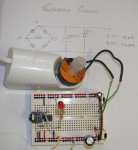These could be useful for lower power Picaxe projects. I wound a coil on a simple plastic former to drop over the Braun charger. (wire diameter 0.25mm coil resistance 8 ohm ). The coil AC is rectified with 4 standard diodes in the usual bridge layout.
The DC output is about equivalent to a 24V source with 680 ohm internal resistance.
At 9.7V about 14.5 mA is available and at 4V around 24 mA. I have used a zener (assumed around 5V) directly across the bridge output to prevent damage to the Picaxe.
An 08M has been running overnight flashing LEDs and working a piezo sounder without problems.
I had hoped to use this arrangement both to power a Picaxe as well as to provide a mains frequency timing pulse but unfortunately the induction frequency is much higher than 50Hz.
Hope this can be of some use to someone.
The DC output is about equivalent to a 24V source with 680 ohm internal resistance.
At 9.7V about 14.5 mA is available and at 4V around 24 mA. I have used a zener (assumed around 5V) directly across the bridge output to prevent damage to the Picaxe.
An 08M has been running overnight flashing LEDs and working a piezo sounder without problems.
I had hoped to use this arrangement both to power a Picaxe as well as to provide a mains frequency timing pulse but unfortunately the induction frequency is much higher than 50Hz.
Hope this can be of some use to someone.
Attachments
-
205.1 KB Views: 98

